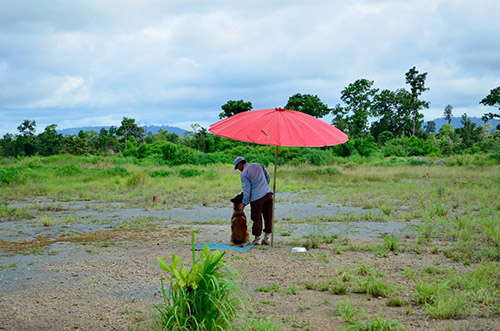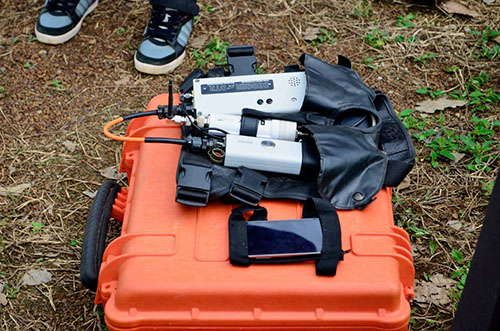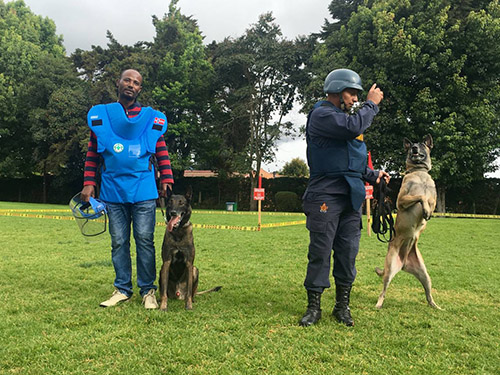How to “clean” and “liberate” contaminated territories occupied by remnants of war? How to perceive and remove explosive devices specifically designed to evade detection? How to remedy and undo the suspicion deeply sown in rural landscapes? In the political context of peace negotiation and post-agreement in Colombia, land decontamination and (partial) recovery has not been an exclusively “human” humanitarian affair. On the contrary, other species and nonhuman actors have been indispensable in the work of detection and in the slow but essential effort to regain trust, not only among former enemies, but also between rural communities and territories. In the case of Colombia, mine-sniffing dogs have been the best co-laborers (de la Cadena 2015, 12).
Interested in what I have called the “nonexplosive capacities of landmines,” I conducted most of my two years of fieldwork in the Pilot Project of Humanitarian Demining. Announced in March 2015, the Pilot Project required guerrilla members and soldiers of the national Army (who were still at war) to live and work together in order to “clear and decontaminate” two heavily mined villages in Colombia, El Orejón and Santa Helena. A sui-generis peace experiment, the Pilot Project aimed to prove, ‘on the ground,’ that an alliance between adversaries is not only possible, but also, as a guerrilla member put it, “the first step towards the irreversible path to peace.” The goal was both political and environmental: to dismantle the literal and figurative landscapes of suspicion that had been put in place by and through improvised landmines during the decades-long civil war.
The guerrilla and the Army received the technical and political support from the renowned humanitarian demining organization Norwegian Peoples Aid. The NGO team was made up of expatriates (some of them former soldiers) from Norway, Bosnia and Herzegovina, Serbia, and Ethiopia. The international demining team also included two Belgian Malinois Shepherds: Hamilton and Rambo. The Belgian Malinois Shepherd is a well-known working dog breed, particularly famous in the demining world for their extraordinary sensory perception, physical strength, and mental traits. These dogs are specially bred and trained as animal detectors and deployed in highly mine-contaminated countries.
This text explores my first encounters with these professionally trained Mine Detection Dogs and their human handlers, a couple of weeks before I entered El Orejón, the first Pilot Project site. Oddly enough, these initial ethnographic moments did not take place in rural Colombia, but rather in the countryside of Cambodia. The goal of the visual and textual scenes that follow is twofold: first, I want to illustrate that the humanitarian world of demining is always already a more than human enterprise; second, I want to suggest, albeit incipiently, that these nonhumans are actors and nodes that link wars, explosive remnants, technical expertise, and caring practices and materialities across the globe (Latour 2005; Law 2009).
The Encounter

Photo 1: Human handler and Mine Detection Dog resting in training field in Ratanakiri, Cambodia. Photo by the author.
The Mine Detection Dog (MDD) unit is a human-canine duo that trains and works together to perceive and indicate the possible presence of explosives in suspicious landscapes. This first image (Photo 1) captures my first encounter with several of these “more than human” couplings on August of 2015 in the Ratanakiri province in Cambodia. After more than forty post-war years, the Southeast Asian countryside remains riddled with both antipersonnel mines and unexploded ordinances. I met these ‘units’ while they were training. From a distance, I glimpsed a dog walking straight, snout touching the ground, tail pointing up to the sky and wagging. A nearly motionless but attentive man shouted commands that were incomprehensible to me. A long leash tied the dog and the human to each other. I observed how the dog seemed to disappear in the long grass, only to reappear moments later. The scene was repetitive but also captivating; monotonous but also intimate.
I learned that day that these dogs receive commands in Norwegian, no matter where they are ‘transferred,’ as they are bred and trained in the central MDD academy of Norwegian People’s Aid, the Global Training Center. The GTC, as it is known by its acronym in English, is located in Bosnia Herzegovina and is responsible of breeding and training more than one hundred MDDs per year. In fact, a significant percentage of the dogs working in the demining world today come from this academy, making the GTC one of the leaders of the international humanitarian dog industry.
In the distance, I also saw other ‘units’ resting after training. I spotted a pooch and a human under the shade and protection of a colorful red umbrella, holding each other’s gaze and caressing each other with (what seemed to me to be) tenderness and affection. Becoming a ‘multi-species unit’ requires careful observation and dedication. Demining is an arduous and risky task that requires trust. According to experts on canines, it is through training that one part learns to know the other, to identify each other’s skills and needs, to manipulate each other’s behaviors, expectations, and moods. Joint demining work requires the constant practice of attuning oneself to one’s partner and posing the same question repetitively: how to be open to affect while also being affected. Affect is at the center of the process through which dogs and humans become a ‘unit.’ In training, dogs and humans work to produce, solidify, and maintain bodily differences, affective (de)attachments, and specific work distributions and vulnerabilities. In training, as a relational affective practice, both dog and human are (re)made together and in relation to one another (Pardo Pedraza 2019).
A Cyborg Ecology

Photo 2: Vest prototype for Smart Detection Dogs. Photo by the author.
I was in Cambodia for a six-week intensive training organized by the Norwegian People’s Aid, as part of its role in the Pilot Project of Humanitarian Demining. I joined a group of eight humanitarian staffers from Colombia and Myanmar who went to different Cambodian provinces to learn about Land Release, the current mainstream and cost-efficient methodology in humanitarian demining. The training included a weeklong workshop on ‘animal detection technology’ led by several Bosnian canine experts, who had worked for long stints at the GTC, and their Cambodian counterparts. They explained that the MDD unit (i.e., human and dog) is a tool in what they called the comprehensive demining toolbox. That is, it is part of a technical ecology populated by human deminers with metal detectors and gardening gadgets (the manual capacity) and by mine-sweeping machines with moving chains and hammers (the mechanical capacity).
During those days, I also learned that ‘the animal capacity’ has at least three types: Mine Detection Dogs, Explosive Detection Dogs, and Smart Detection Dogs. Still a prototype, the latter sought to solve the limitations of long-distance visibility and the reception of commands in the deployment of ‘off-leash’ canines. Smart Detection Dogs wear a vest with a camera, audio, and GPS, which allows both the dogs’ position and the terrain conditions to be tracked (Photo 2). The vest also sends commands regardless of distance.
According to the Land Release approach, a safe, reliable, and economical demining operation requires a diverse repertoire of clearance devices and techniques, whose combination depends on and responds to the specificities of the weather, soil, and contamination conditions of the place of intervention. Humanitarian demining is a muddy, messy, and always more than human business. It is populated by creatures that are and become simultaneously organic and machine, animal and human, natural and crafted. It is a cyborg technical ecology (Haraway 1991).
Becoming Kong

Photo 3: Kongs, small pieces of Kong, and different explosives substances used to impregnate them. Photo by the author.
A couple of days after my first encounter with human-dog couplings, I learned that the duo that is a ‘unit’ only becomes one in relation with an object: the Kong. The Kong is a red rubber toy typically used early in the canine detection training (Photo 3). In the words of some experts I interviewed, Kong becomes the “object of desire” and the “obsession” of mine-sniffing dogs through several early conditioning processes. According to these same experts, it is precisely the pleasure and the affective state of fixation inspired by this object that makes detection training possible.
Dogs are trained to sniff and indicate the presence of explosives. However, in the words of these experts, for the canines, the odor of explosives represents interaction with and attention from their human partner. It is then about enjoyment and pleasure. Through other conditioning processes (i.e., daily, repetitive, and consistent exercises), dogs associate the smell of a Kong, an object that “symbolizes” joy and attention, with the scent of different explosives. Smaller and smaller sizes of Kong are impregnated with mine-chemical substances, which makes the search more challenging, but also (and most importantly) enables the toy-mine correlation.
Inspired by Vinciane Despret (2013; 2004), I have learned to question these narratives of unilateral association and training, and to complicate the possible politics of representation that they might imply (i.e., the Kong stands for the landmine). I have striven, then, to think about these relationships in terms of mutual training and becoming. Humans and dogs are made and remade together and in relation to one another. In this process, landmines are also constantly becoming… Kong. In training, the Kong is transformed into an object that embodies paradoxical but co-constitutive social bonds: pleasure and work, play and discipline, attention and distance, danger and reward.
Binomios Caninos in Rural Colombia

Photo 4: Two binomios caninos during an MDD workshop in Bogotá. Photo by the author.
Deeply entangled in the material practices, ecologies, and process I described above, Rambo and Hamilton arrived in Colombia in May 2015. They settled in the national Army base in Tolemaida to ‘acclimate’ to the country’s environmental conditions (altitude, temperature, humidity) and to train together in the detection of specific explosives used in improvised landmines. They had already been in Cambodia for two months, preparing for relocation and meeting their new human companions: two male handlers from Ethiopia. It was in Tolemaida that these Mine Detection Dog ‘units’ started to be called ‘binomios caninos’ (canine binomials.)
Binomio canino is a specific technical idiom in Colombia (Photo 4). Originally, binomio canino was a local military term. The Colombian armed forces, especially the national police, used the phrase to describe the pair constituted by a soldier and a trained dog working in military operations, particularly in the detection of explosives, mine-breaching, and manual coca eradication. However, binomio canino is now widely used in the Colombian humanitarian demining sector, both by civilian and military organizations.
The Pilot Project deployed a total of six binomios caninos. Hamilton, Rambo, and their respective human handlers were part of this ‘animal capacity.’ Together with the manual and mechanical capacities, these six human and dog detection couplings helped to identify and deactivate sixty-six explosive artifacts and clear and release more than 40,363 m2 of mine-contaminated lands: 19.489 m2 in El Orejón and 20.874 m2 in Santa Helena.
Conclusion
The humanitarian effort is a nonhuman business. The world of mine action is populated by more than human actors. Mine-detecting dogs and their human partners are central to the work of clearing contaminated fields and essential to the effort of liberation and (partial) recuperation of spaces occupied by explosive technologies of war. These ‘units’ or ‘binomios caninos’ are not alone. As I have suggested, their ability to detect depends on their becoming with and working along others, humans and nonhumans: manual deminers, metal detectors, gardener’s kit, mechanical operators, mine-sweeping equipment, etc. When talking about humanitarian mine-clearance, “one is too few, but two are too many” (Haraway 1991, 177). Constituent elements of a demining technical ecology, these humans and nonhumans travel and link worlds created and ravaged by war and its material legacies, as well as worlds rebuilt and released by humanitarianism and its technoscientific practices. With and through them, Colombia, Cambodia, Myanmar, Bosnia, and Norway are partially connected.
References
Cadena, Marisol de la. 2015. Earth Beings: Ecologies of Practice Across Andean Worlds. Durham: Duke University Press.
Despret, Vinciane. 2004. “The Body We Care for: Figures of Anthropo-Zoo-Genesis.” Body & Society 10 (2–3): 111–134. https://doi.org/10.1177/1357034X04042938.
———. 2013. “Responding Bodies and Partial Affinities in Human–Animal Worlds.” Theory, Culture & Society 30 (7–8): 1–26. https://doi.org/10.1177/0263276413496852.
Haraway, Donna. 1991. Simians, Cyborgs, and Women: The Reinvention of Nature. New York: Routledge.
Latour, Bruno. 2005. Reassembling the Social: An Introduction to Actor Network Theory. New York, NY: Oxford University Press.
Law, John. 2009. “Actor Network Theory and Material Semiotics.” In The New Blackwell Companion to Social Theory. John Wiley & Sons.
Pardo Pedraza, Diana. 2019. “Trust in Scales: Humanitarian Demining and Peace Laboratories in Rural Colombia.” PhD Thesis, University of California, Davis.
